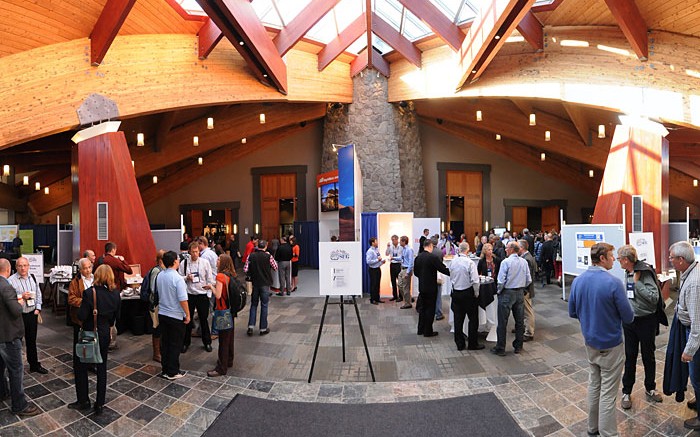WHISTLER, B.C. — More than ever it seems the mining industry is trying to achieve efficient exploration and development: making lower-cost, geologically economic discoveries, and advancing these deposits towards production.
These are concepts that appeal to companies of all sizes — from large-cap miners to greenfield explorers — and they lie at the heart of the Society of Economic Geologists’ (SEG) annual Geoscience for Discovery conference at Whistler, B.C.
The SEG’s goal is not complicated, but it’s important: bridging the gap between geoscientific academia and the natural resource industry.
It’s evident during the event that the goal is shared by all segments of the mining community. Large companies like Teck Resources (TSX: TCK.B; NYSE: TCK), Anglo American (US-OTC: AAUKY; LON: AAL), BHP Billiton (NYSE: BHP; LON: BLT) and Rio Tinto (NYSE: RIO; LON: RIO) are significant sponsors and participants, while researchers and academics from universities and think tanks around the globe offer insight into cutting-edge geoscience.
“Here’s an opportunity to get industry and academia working together in a way that could lead to real benefits for explorers,” says conference president and co-chair Gerry Carlson during an interview. “And I think it’s been successful, as we have gotten the two sides talking to each other.”
He says the SEG has been following that model with its keystone conferences: “If you listen to our talks here, some of them are by industry people and some are by academics — but in the back of everyone’s mind is just how this may lead to that next great discovery.”
SEG has done its research. First it studied deposits in different ways, hoping to keep an open mind geologically while looking at districts and regions. As an example, Carlson brings up a presentation by Teck’s regional chief geoscientist in South America Claire Chamberlain, where she discussed under-saturated alkalic porphyry deposits in B.C.
“Sometimes regions are unfairly characterized as being small and low grade. One of the points I’ve heard during the talks is that erosion levels in these copper-gold porphyries are important, and sometimes in certain districts a lot of deposits have been eroded away, whereas in other areas they’ve yet to be exposed,” says SEG organizing committee member Steve Robertson of Vancouver-based Imperial Metals (TSX: III; US-OTC: IMPLF), pointing to the work his company has done at its development-stage Red Chris copper-gold project in northern B.C.
“It would take deep exploration to show the true characteristics of the deposit. Our exploration at Red Chris was inspired by other groups that had been exploring elsewhere in the world, and finding the deeper roots underneath what appeared to be higher levels of deposits,” he says.
Carlson and Robertson agree that one of the more interesting aspects of SEG’s work is taking geological models from one region of the world, and exploring how the pieces fit together closer to home.
For example, Simon Richards of James Cook University in Australia presented his research on tectonic preconditioning and giant porphyry-deposit formation, focusing on large-scale projects in Southeast Asia, like Freeport-McMoRan Copper & Gold’s (NYSE: FCX) massive Grasberg copper-gold mine in Indonesia.
“I think in that regard there is a lot of potential in B.C. The showings are known, the alterations are known at surface, but maybe people have walked away before doing enough drilling,” Carlson says, citing Colorado Resources’ (TSXV: CXO) North ROK copper discovery as an example. “It’s been known forever, and [in mid-year] they hit the sweet spot, which gives you that momentum to drill enough holes to potentially nail down a deposit.”
SEG hopes to underline the importance of tectonic, regional and district-scale geological approaches to mineral exploration, noting that Cordilleran regions have benefitted from an explosion of research and understanding of terrane concepts and orogenic processes.
Robertson — who once served as a technical advisor for Geoscience B.C. — says there is a role for public geoscience in the process as well. He says that the public geoscience initiatives for New Gold’s (TSX: NGD; NYSE-MKT: NGD) Blackwater gold deposit are an example of how government-funded regional programs can help the industry find district plays.
“Even though these systems are big, they are not that big. It’s easy to miss them when you fly over northern B.C. and see how vast the wilderness is up there . . . it’s not hard to imagine a lot being hidden there yet,” Robertson says. “And all of us really enjoy that interaction, because on the government side, the geologists are out there mapping the rocks on a regular basis, so they’re a great resource.”
Technology and new exploration techniques are another focus for SEG. Carlson says he often hears that the oil and gas industry is far ahead of the mining industry in terms of 3-D seismic modelling and general geophysics. He notes that work is being done at the University of British Columbia on 3-D modelling and geophysical data that could lead to new techniques for explorers.
He also points to Geotech’s new ZTEM audio-frequency magnetic system, which can be operated by a helicopter or a fixed-wing aircraft.
SEG’s conference exudes an optimism that is sometimes lacking in the mining industry, given the current market strain. It provides a platform where everyone from prospectors to executives of multi-billion dollar companies can exchange ideas, and take those ideas back into the field to make exciting discoveries.
“We as geologists always need to be open-minded,” Robertson says. “A good example of that is diamonds in the Northwest Territories. When I was going to university, it pretty much wasn’t believed that there were diamonds in the entire North American craton, and that has been proven wrong. So you have to be careful not to fall into those preconceived notions.”


Be the first to comment on "SEG conference explores the future of geoscience"